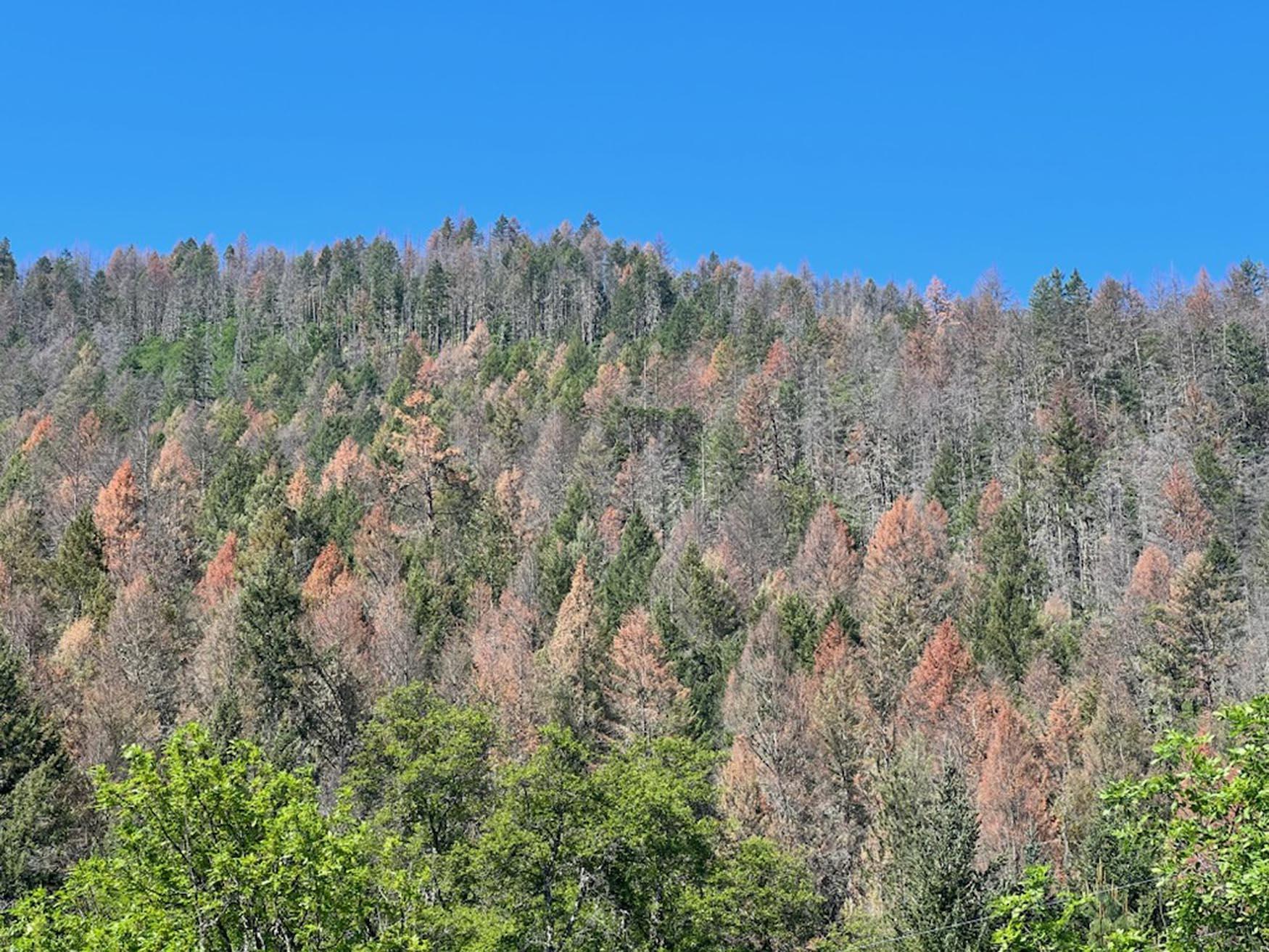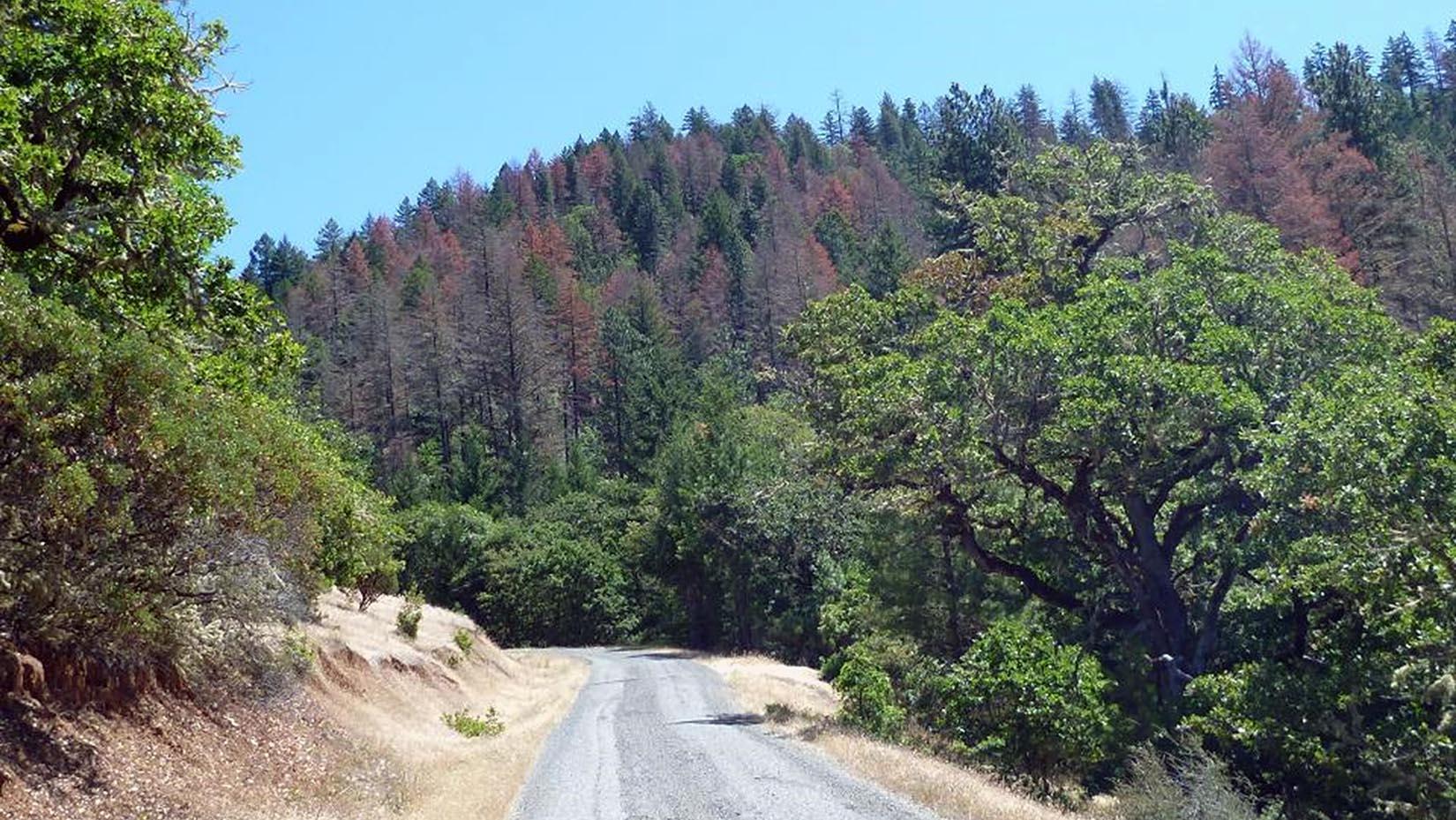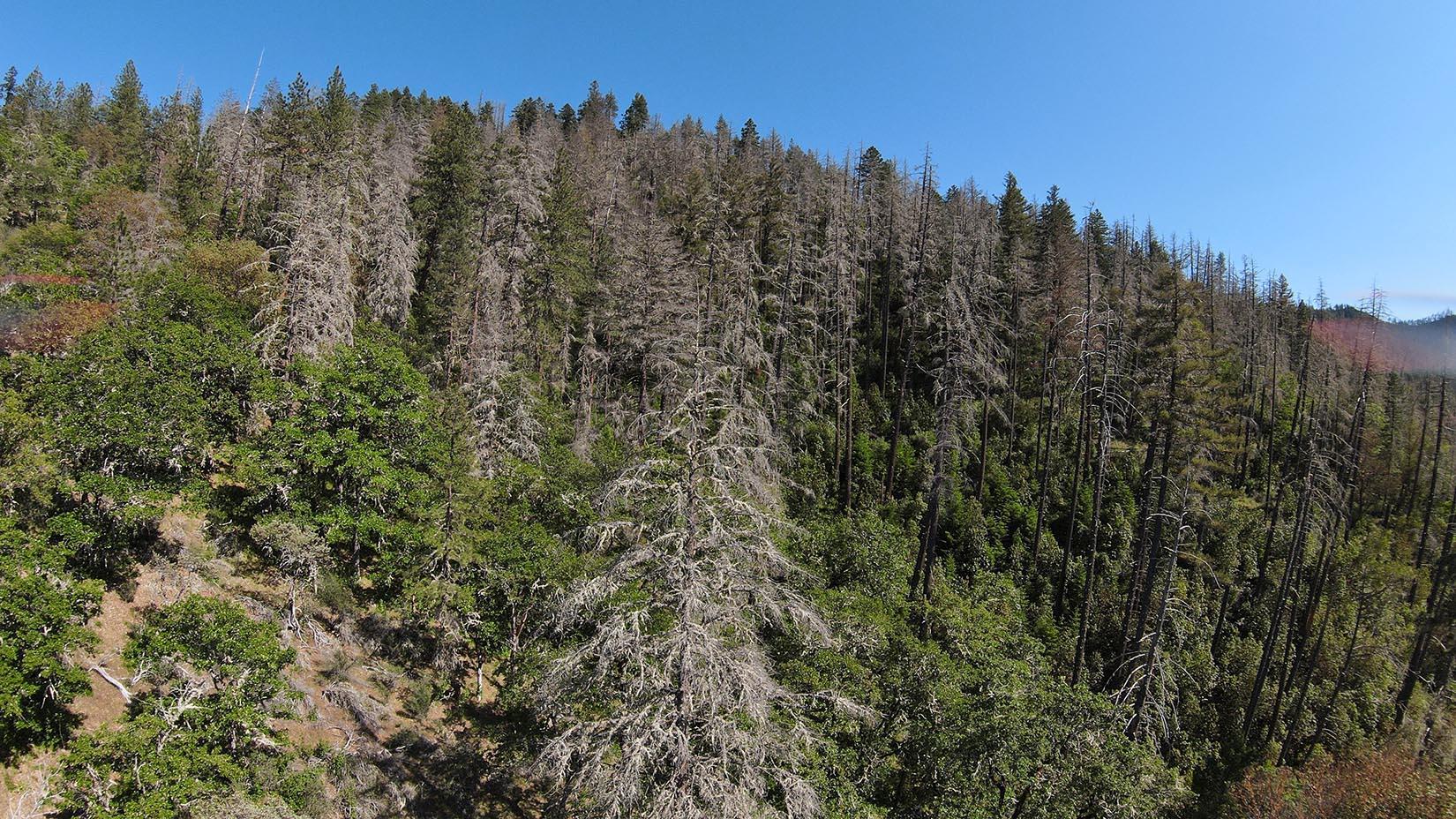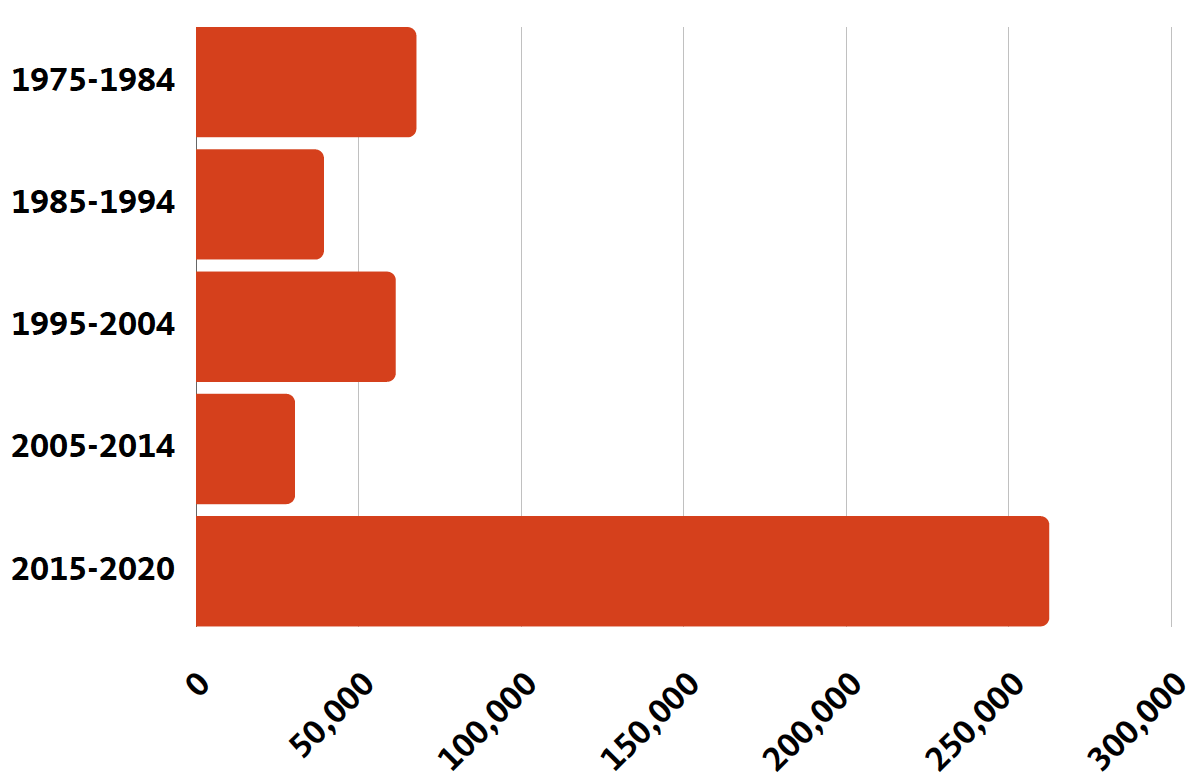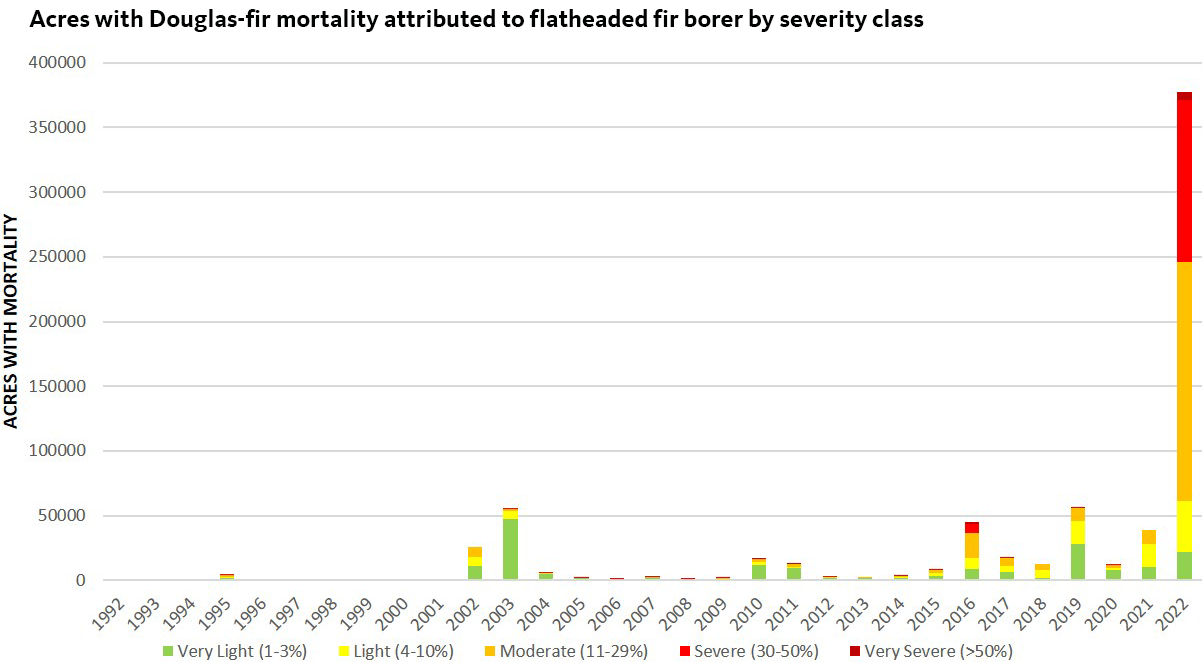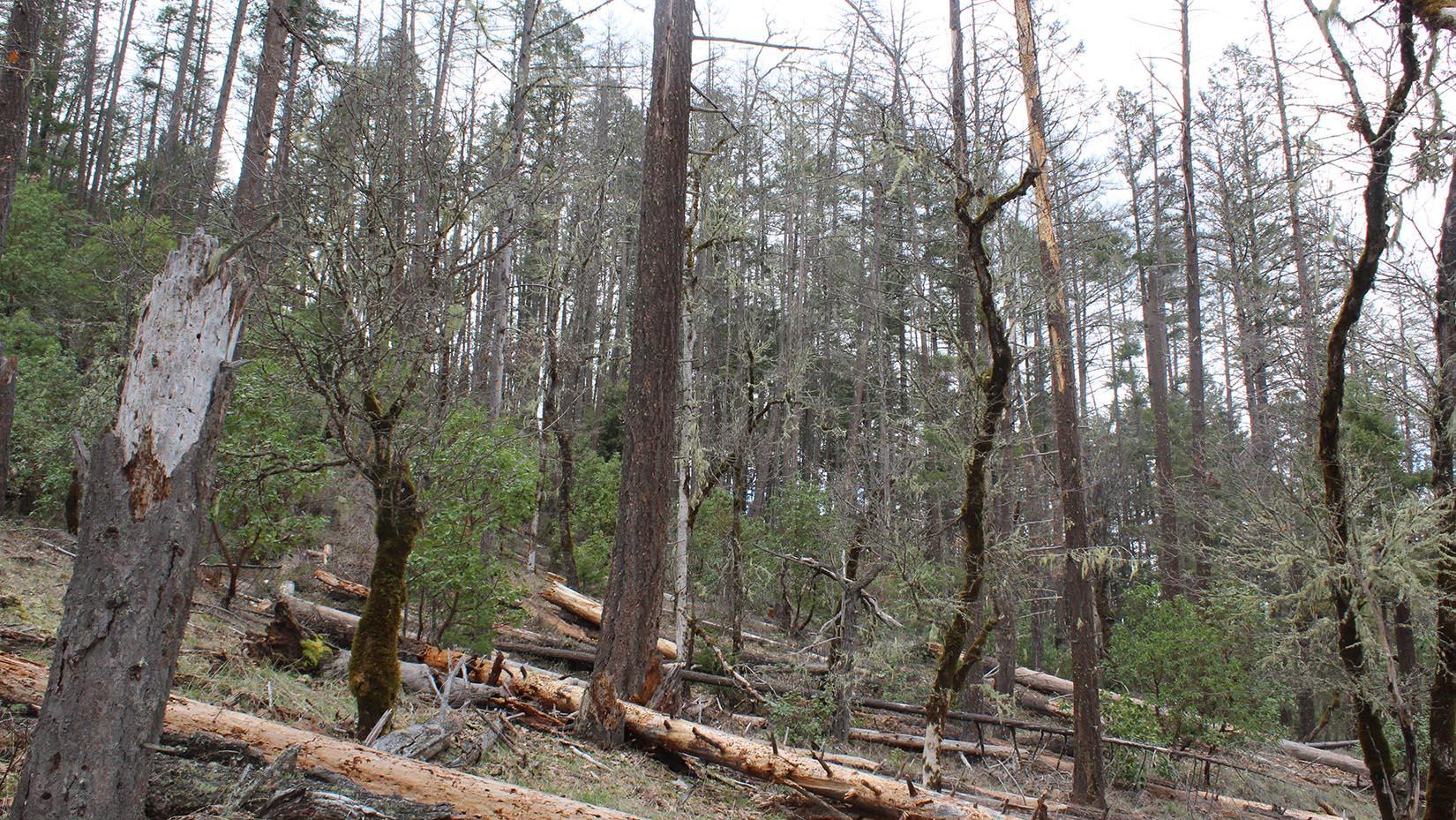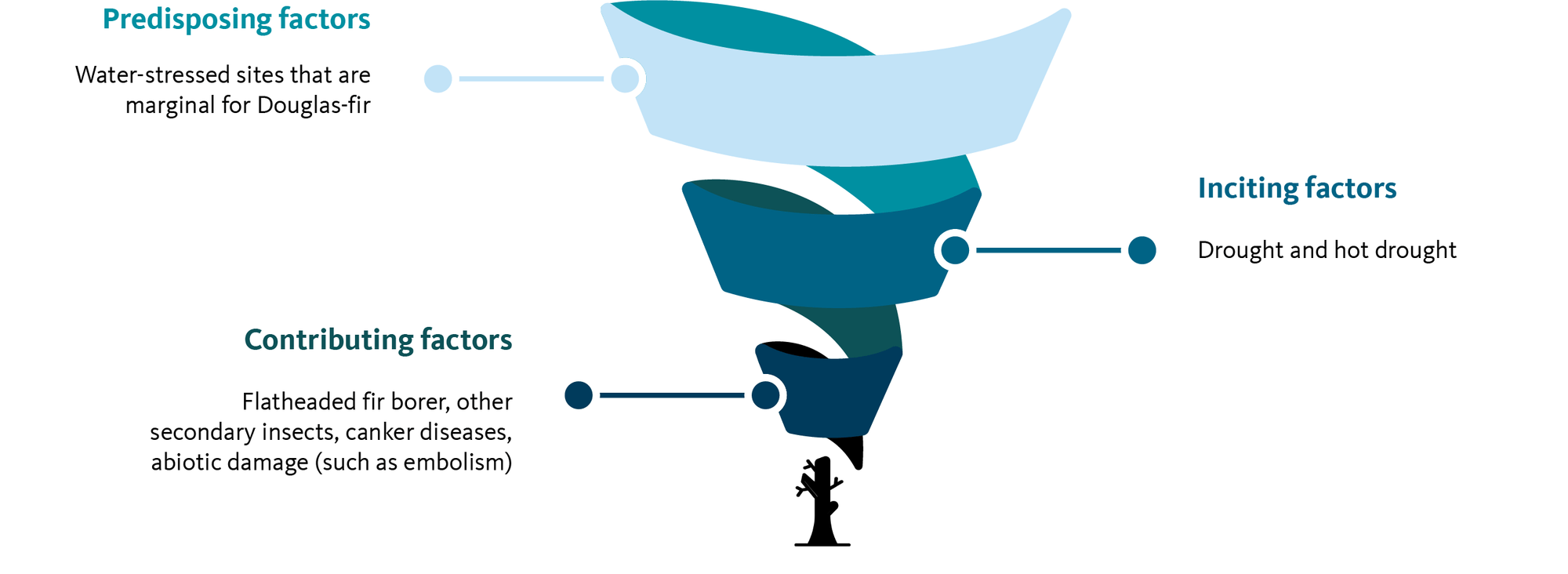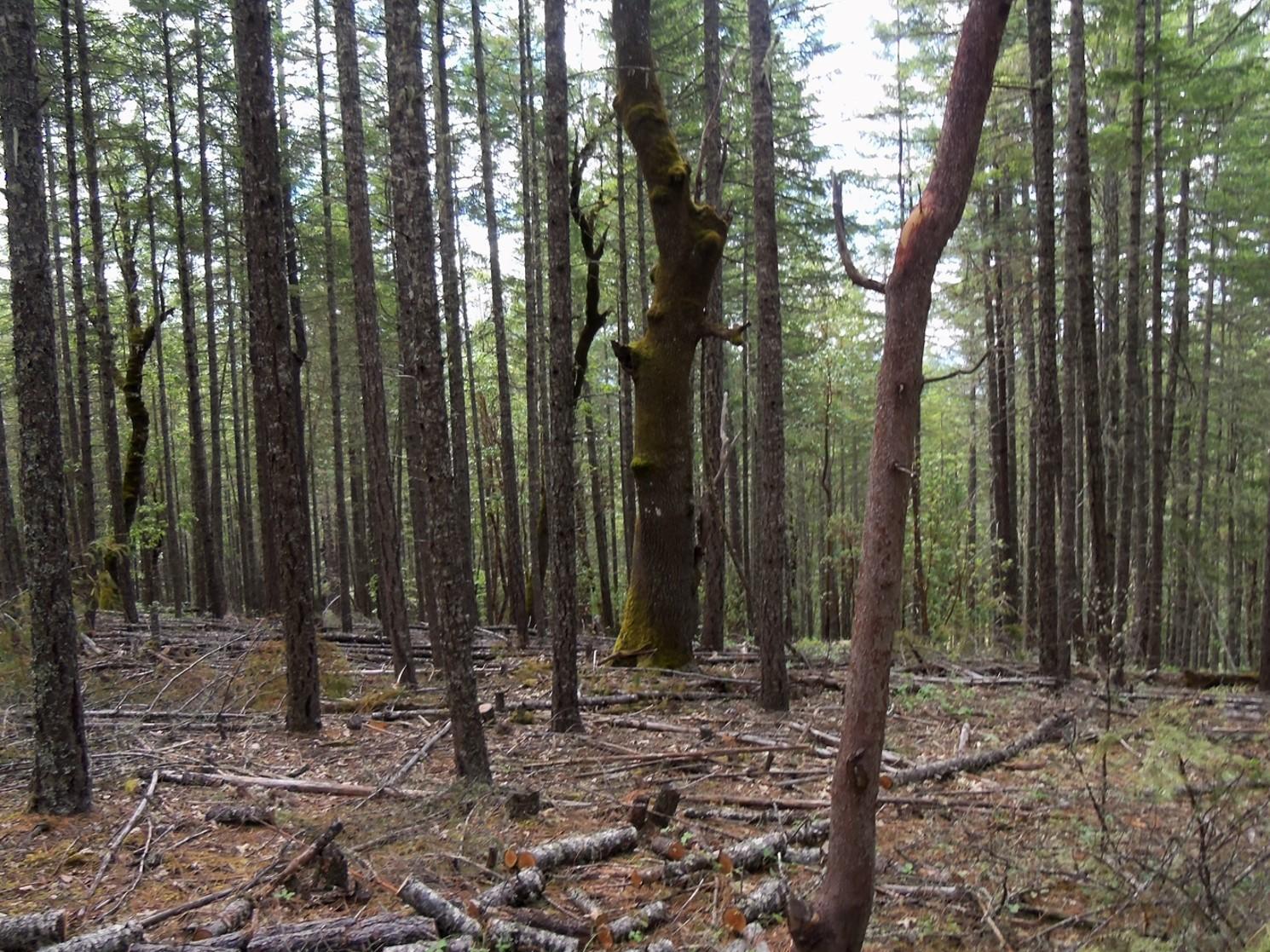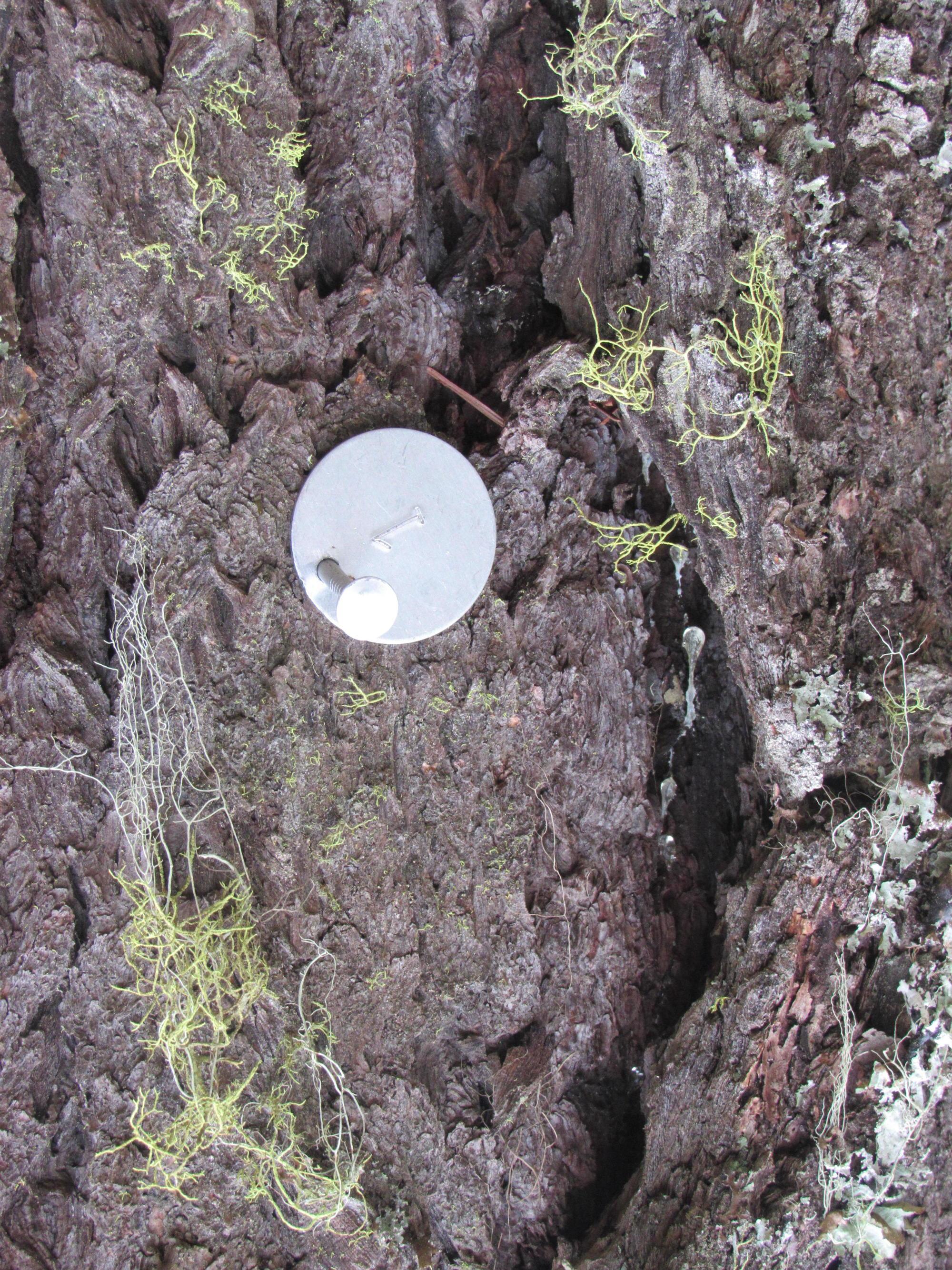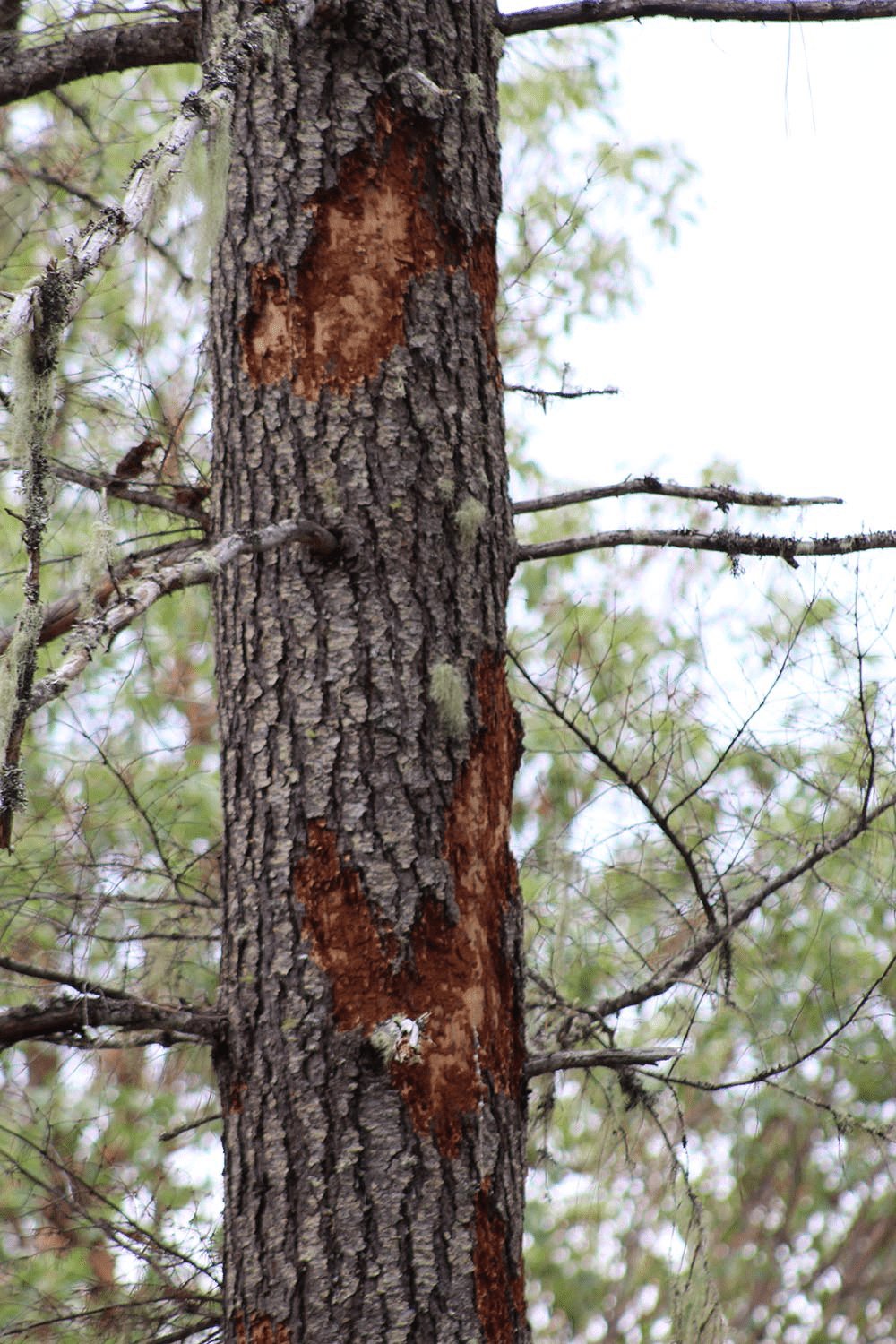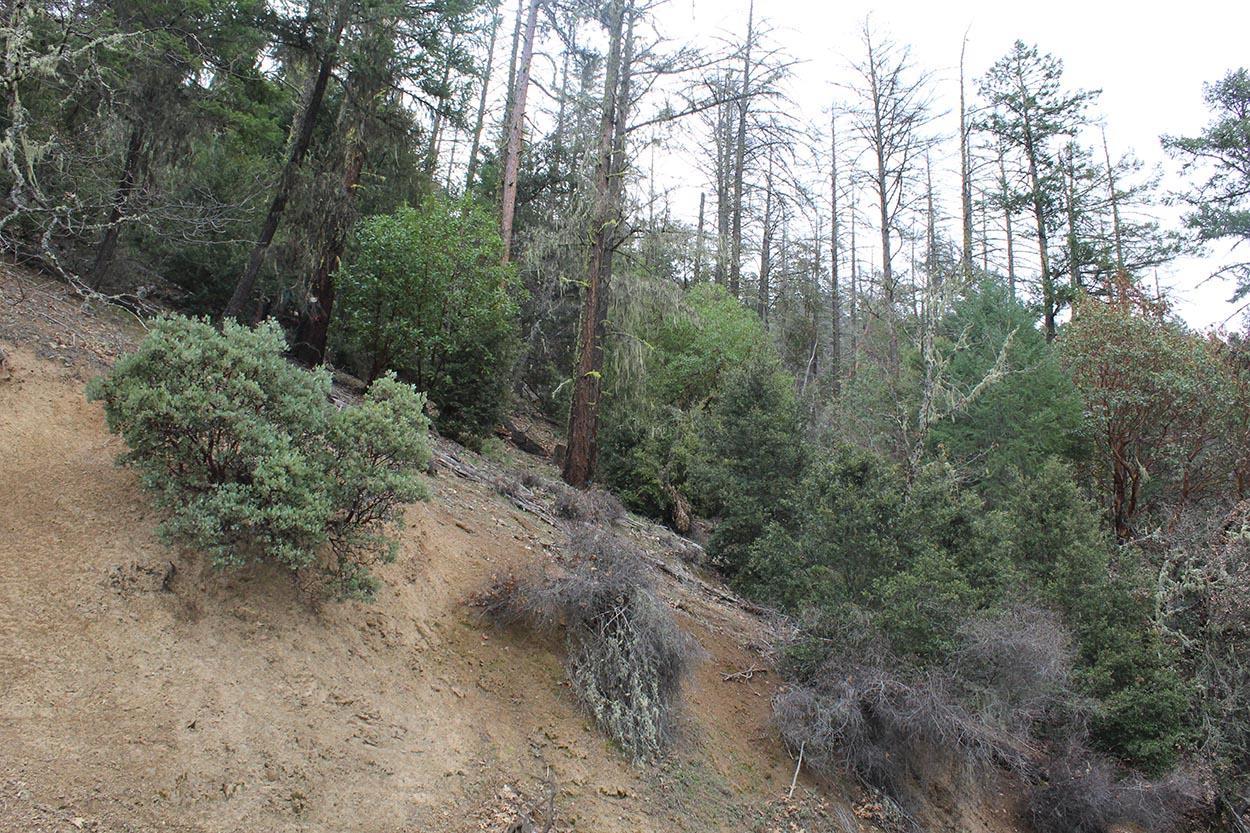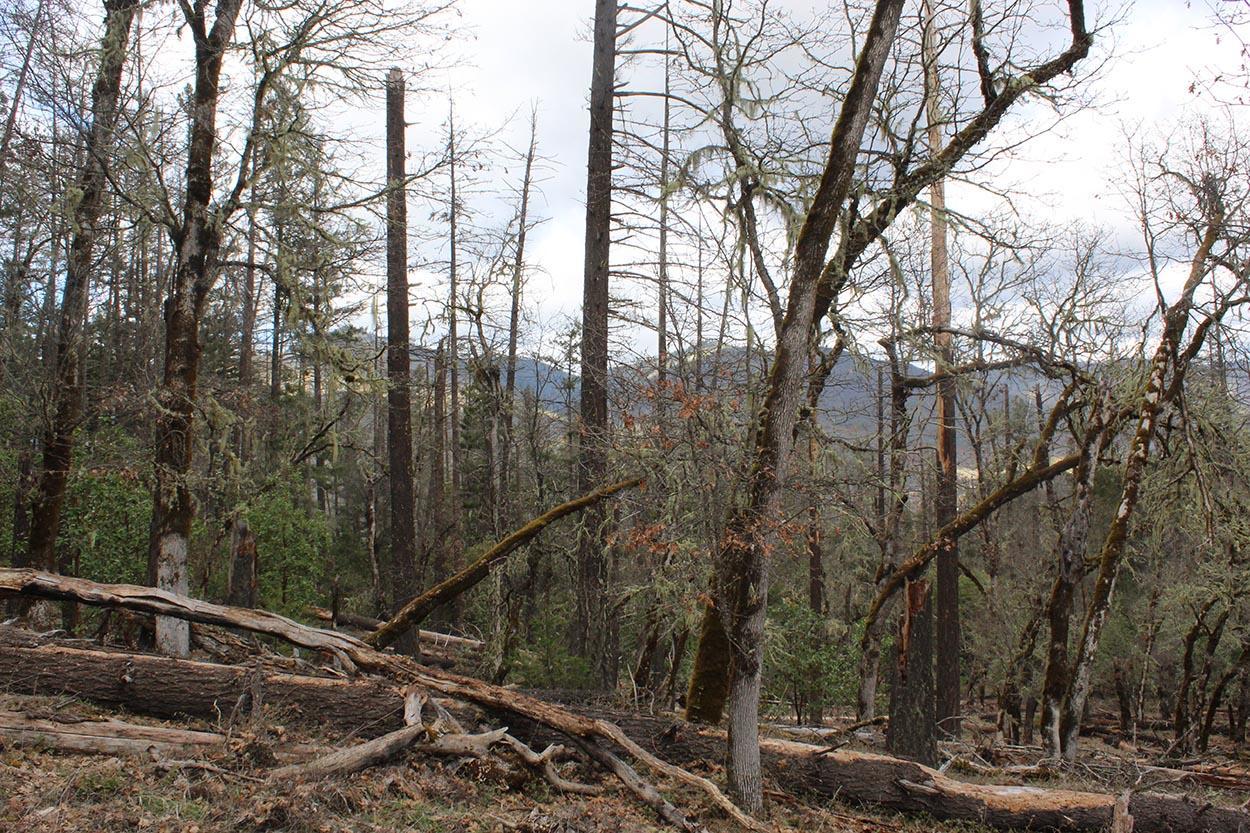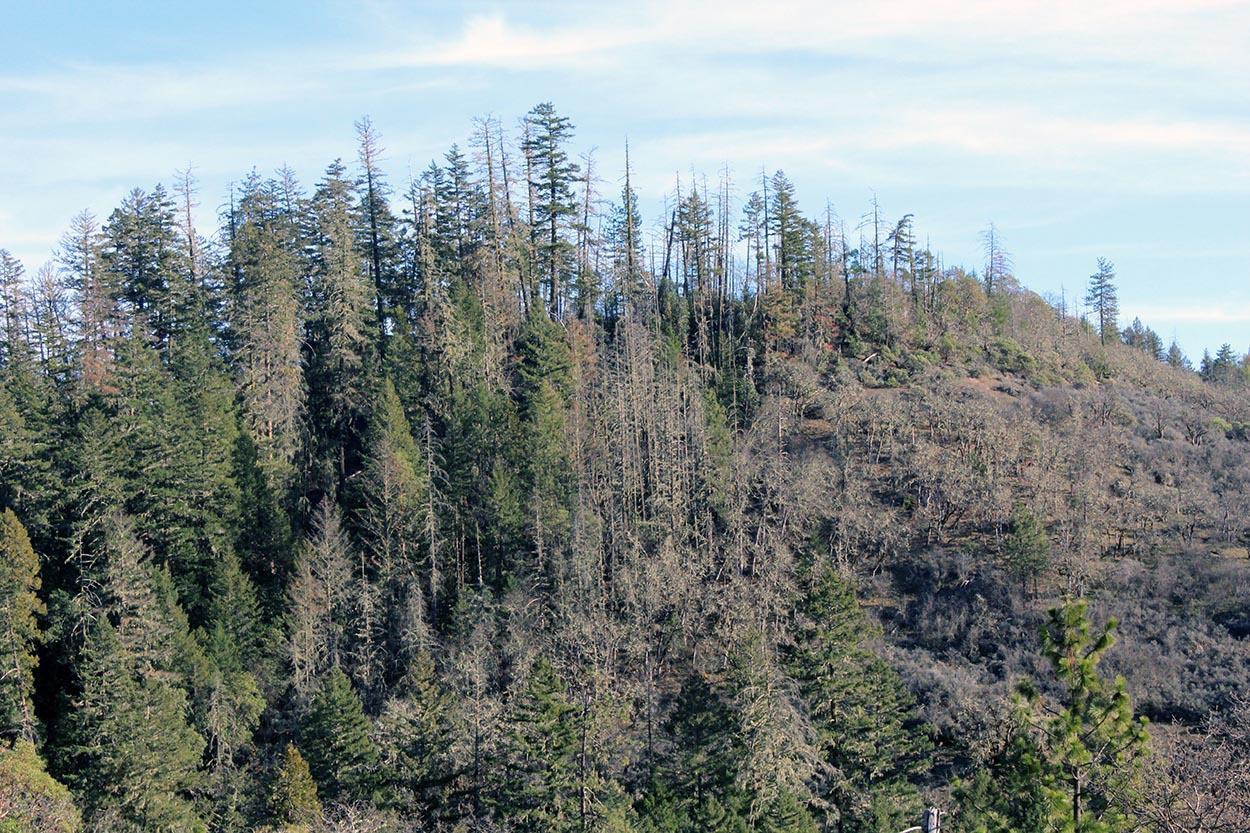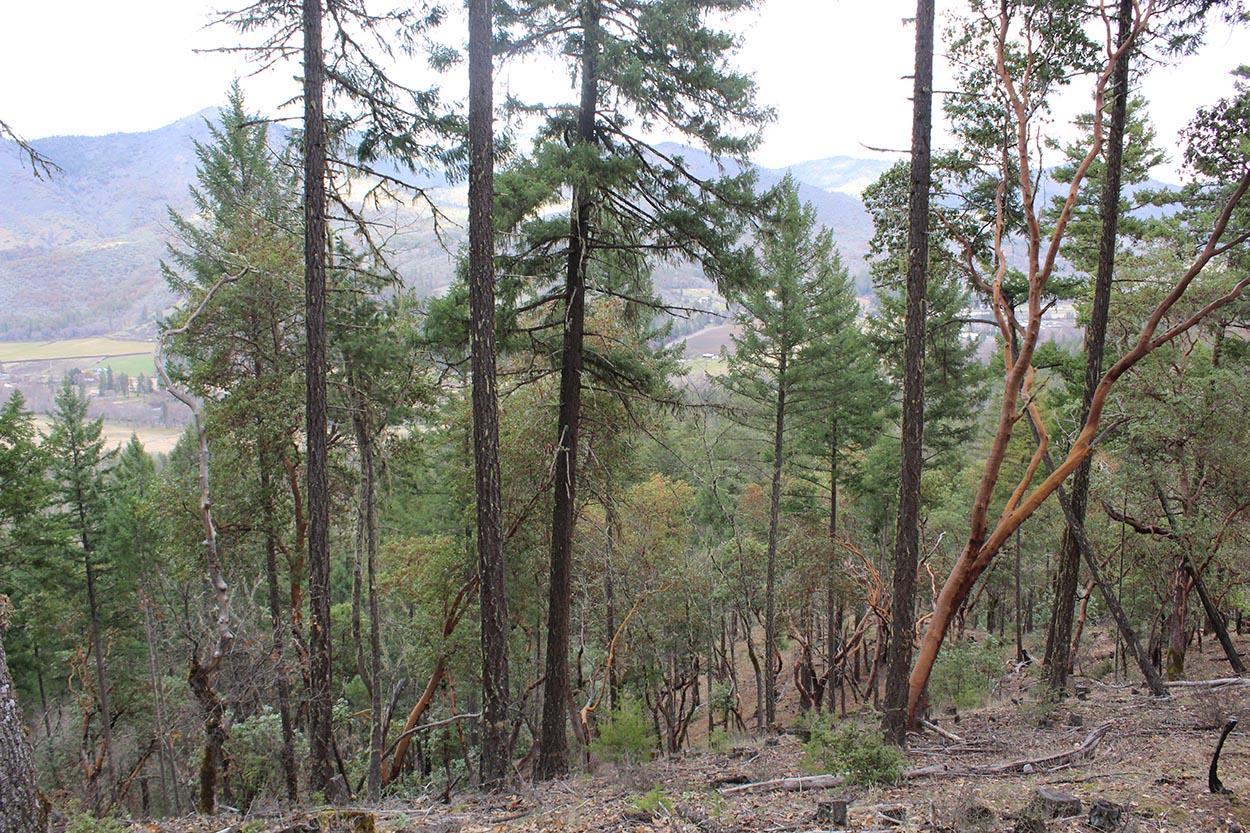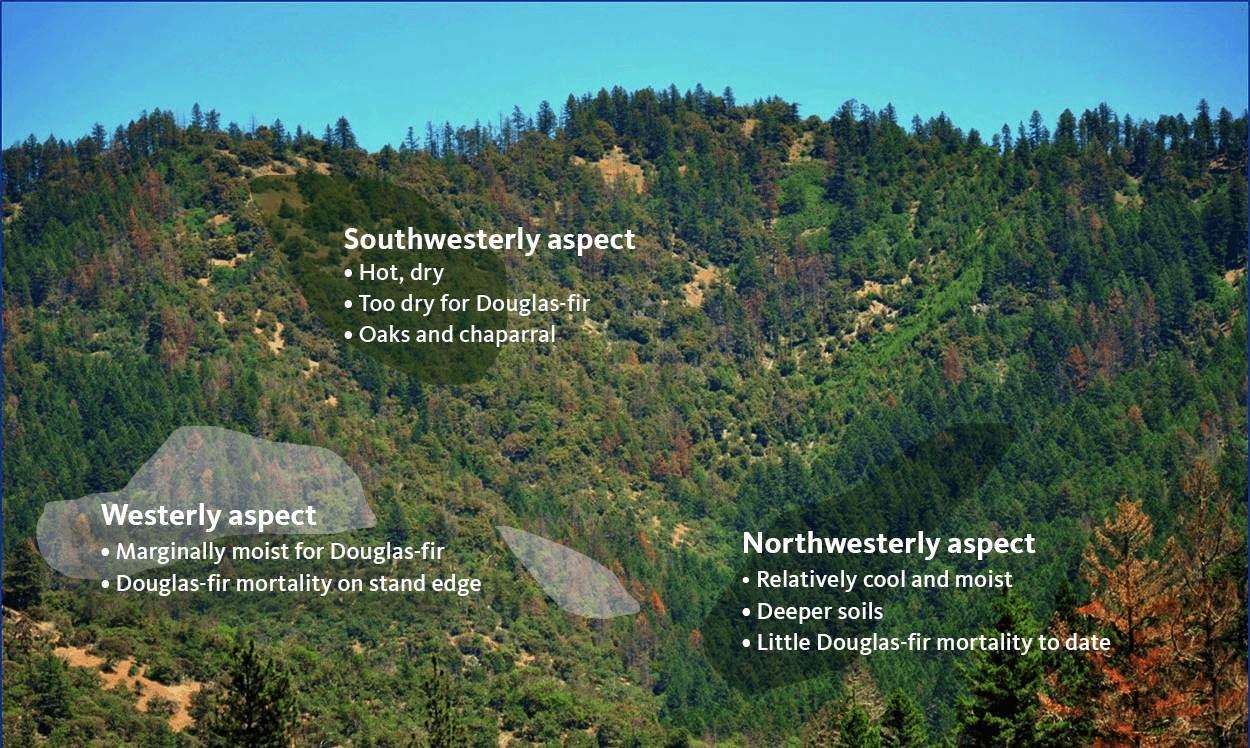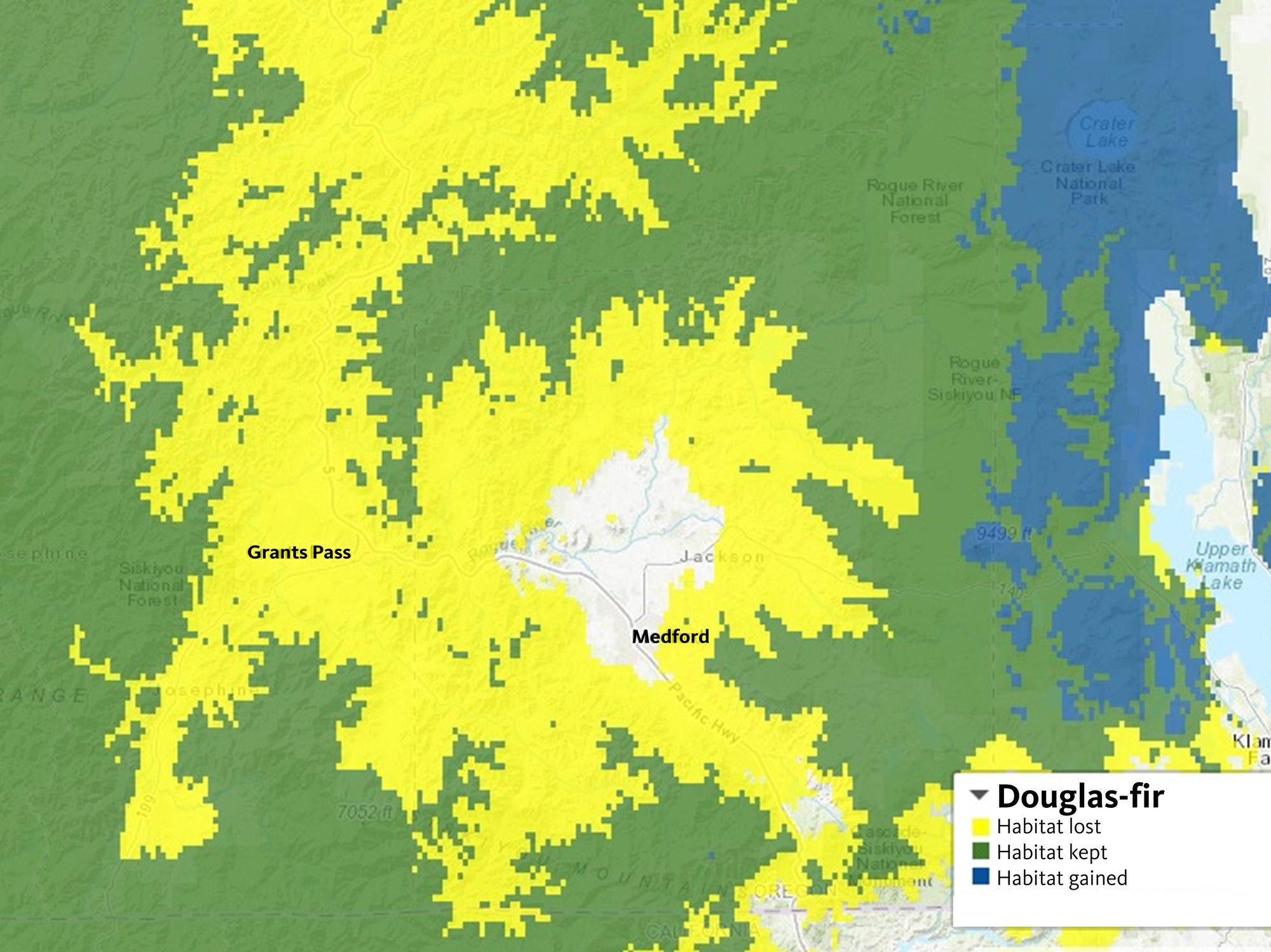The importance of Douglas-fir
Douglas-fir is the dominant tree species in many low- to mid-elevation forests across southwest Oregon. Douglas-fir trees provide vital wildlife habitat, are an important source of timber, and capture and store carbon. However, a rising number of Douglas-firs in southwest Oregon are dying. People want to know: Can this dieback be reduced or prevented? What are the long-term prospects for Douglas-fir in this region? How do we manage the dead trees? What about the risk of wildfires? This publication answers frequently asked questions about why and where Douglas-firs are dying and what actions we can take.
How serious is Douglas-fir decline, and how does it compare to historical trends?
Douglas-fir mortality in Jackson, Josephine and Douglas counties is a serious and growing issue. Douglas-fir dieback has increased dramatically since 2015, with an estimated 260,000 trees killed and nearly 150,000 acres affected from 2016 to 2019 (Figures 1–3). These numbers are based on annual aerial survey data collected by the Oregon Department of Forestry and the U.S. Forest Service and apply in cases where the survey attributed Douglas-fir dieback to an insect called the flatheaded fir borer (see “Causes of Douglas-fir decline and mortality”).
Before 2015, Douglas-fir mortality in the region tended to increase for a year or two during or immediately after drought. It would then subside. But since 2015, mortality levels have remained high. Based on aerial survey data, more trees died in the four-year period from 2015 to 2019 than in the previous four decades (Figure 5).
More recent aerial survey data suggest that mortality levels are increasing. Likewise, 2021 data from field plots in four warm, dry sites in southwestern Oregon indicated that 20% or more of the Douglas-fir basal area in those areas had died in the previous five to 10 years. Basal area is the cross-sectional area of trees, measured in square feet per acre. It is a commonly used measure of stand density.
The most severe dieback has occurred in the Applegate Valley and the fringes of the Bear Creek Valley. But the dieback is widely distributed from northern Douglas County to Northern California, primarily on warm, dry, low- to mid-elevation sites (Figure 5).
What are the impacts of this mortality event — ecologically, economically and culturally?
Dead and dying trees are essential components of a healthy forest ecosystem. But when the scale and amount of mortality become excessive, serious ecological impacts may result. These include:
- The buildup of high fuel loads that increases the risk of high-severity wildfires (Figure 6).
- The loss of large live trees that are valuable for wildlife habitat, fire resistance and healthy watersheds.
- Reduced carbon storage.
- Damage to desirable trees from falling snags (standing dead trees).
Potential social and economic impacts of Douglas-fir mortality include:
- The loss of current and future timber production.
- The cost of removing hazard trees.
- The cost of treating Douglas-fir mortality patches to reduce hazardous fuel loads.
- Impacts on infrastructure such as roads, recreation areas and trails.
- Safety concerns from falling snags.
- Increased difficulty of wildfire suppression and hazard to firefighters.
- The negative impact of a declining forest on aesthetics and recreation.
For the many landowners who have been affected, Douglas-fir mortality often represents a loss of tree cover, shade and aesthetic value. Perhaps a cherished forest is changing in undesirable ways. For owners who manage their woodlands for timber production, the dead trees represent a loss of future income. Increased fuel loads make remaining trees more vulnerable to wildfires and can substantially increase the risk of home loss.
Dead trees are a hazard if they threaten to fall on houses, outbuildings, fences and roads. Removing dead trees or cutting, piling and burning heavy slash loads can cost more than $5,000 per acre in some cases.
Whether for economic, ecological or other reasons, seeing the forest decline is also a source of grief for many landowners who are attached to the places they call home. These landowners want to know how to save remaining trees and preserve forest health.
How does widespread tree mortality affect wildfire hazard?
Consider the effects of Douglas-fir mortality on wildfire hazard in the larger context of wildfire patterns in southwest Oregon. For millennia, wildfire played a key role as a natural disturbance agent, shaping vegetation patterns across the landscape. Historically, frequent fires of low to mixed severity interacted with a number of factors to create a diverse patchwork of forests. Many of these forests were more open than the forests of today. Frequent fire had other effects, including:
- Cultivating large, open-grown trees.
- Hindering extensive regeneration of fire-intolerant species.
- Promoting fire-tolerant species and understory diversity.
- Maintaining gaps in the tree canopy.
- And decreasing the compounding effects of insects and diseases.
The absence of frequent low- and mixed-severity fires and the removal of large, fire-resistant trees have altered vegetation patterns. Currently, many dry forest stands are overly dense. Surface, ladder and canopy fuels have accumulated well beyond historic levels. This increases the potential for larger-scale, stand-replacing fires.
The effects of extensive tree mortality are complex and vary over time. In general, trees that have died recently and have red foliage (the “red phase”) are extremely flammable. Crown fire potential and ember production are high during this stage, which may last from a few months to a couple of years.
When the needles fall off (the “gray phase”), crown fire potential declines and fine surface fuels (twigs, small branches and understory vegetation) accumulate. This phase may last for a decade or so.
As the dead trees start to decay and fall apart (the “old phase”) and new shrubs and trees grow back, surface fuel loading increases dramatically. This phase lasts for decades. During this time, fire intensity, crown fire potential and ember production all increase, and fires become more difficult to suppress.
In some areas of dead Douglas-fir, many large logs litter the ground, while shrubs, hardwoods and grasses respond to higher light levels and regenerate. In a wildfire situation, this combination of factors can lead to extreme fire behavior with high flame lengths and prolonged soil heating over large areas. The long duration and magnitude of soil heating may also result in significant losses of soil organic matter. Roots and soil biota sustain damage, and the erosion potential increases.
High-severity burns may also hinder regeneration of new trees — particularly conifers — and result in the loss or top-kill of any trees that remain. Extensive areas of high-severity fire suffer loss of forest cover, heavy smoke production, loss of timber, increased potential for high-severity reburns, and increased sedimentation and peak flows. This is especially true in lower-elevation forests where high-severity fire was historically uncommon and species are adapted to frequent, low-severity fire.
Potential implications of Douglas-fir mortality for fire management and firefighter safety include:
- Increased flame length and long-range spotting.
- Increased fireline construction time.
- A reduction in effective safety zones.
- Risks to firefighters from falling snags.
- Challenges for predicting fire behavior.
- And increased cost and duration of wildfires.
Locations that may have previously offered strategic opportunities for firefighters to stop the spread of fire may no longer be suitable due to extreme fire behavior and safety hazards.
Are forests likely to recover, or is the loss of forest cover permanent?
In areas with heavy Douglas-fir mortality, mature pines, madrones and oaks may remain viable, providing some continued canopy cover. In areas where Douglas-fir has become more prevalent, these other species may benefit from the reduced competition. Where canopy cover is severely reduced, grasses and shrubs will typically dominate initially. But new trees will often regenerate in the understory. Madrones regrow rapidly in the newly available sunlight. Pines, oaks, and Douglas-fir seedlings and saplings may also be present.
Douglas-fir may be able to survive as small trees, perhaps sheltered by other vegetation. Small trees require less water than mature trees. That doesn’t mean they will be able to grow into and survive as dominant canopy trees, especially on harsher sites. These newly recruited Douglas-firs are likely to die once they reach a size at which water is limited. Without repeated high-severity fires or timber harvest, a forest will eventually reoccupy the site. But the new forest will be composed of different species, such as a pine-oak woodland or savanna.
Fuel loading in many Douglas-fir “snag patches” is high, or will be as dead trees fall to the ground and understory species respond to increased light. If wildfire occurs in these patches under hot and dry conditions, it will likely have severe effects. Soil will lose organic matter and seed due to the heat generated from burning large fuels. Shrubs such as manzanita and ceanothus will frequently return to the site, but tree regeneration may require decades. In extreme cases, the site may be converted to nonforest vegetation for long periods of time.
Causes of mortality
What is causing Douglas-firs to die?
In 1991, plant pathologist Paul Manion introduced the concept of a “disease decline spiral.” In such a spiral, a combination of predisposing, inciting and contributing factors leads to a progressive loss of vigor and tree death.
Manion’s framework is helpful for understanding the recent increase in Douglas-fir mortality in southwest Oregon. In this situation, Douglas-fir trees growing on marginal, water-stressed sites (predisposing factors) are more vulnerable to episodic drought stress (inciting factors) that impairs their physiological functioning. This makes them more susceptible to the flatheaded fir borer and other insect pests and diseases (contributing factors), resulting in tree decline and death (Figure 7). Although Douglas-fir dieback may appear to be rapid, affected trees have often declined over many months and even years.
The most important insect contributing to the uptick in mortality is a native beetle called the flatheaded fir borer. This insect attacks and often kills Douglas-fir trees that are under severe stress, often from drought. Several secondary beetles and canker fungi frequently contribute to branch dieback and top-kill in drought-stressed Douglas-fir. But these insects seldom kill trees on their own (see “Insects and diseases involved in Douglas-fir decline in southwest Oregon”).
When it is very hot and dry, Douglas-fir also can suffer internal physiological damage that makes trees more vulnerable to pests and pathogens. This damage may also cause branch and top dieback and even tree death (see “Hotter drought and tree health”).
Evidence shows that Douglas-fir has expanded into many valley and lower-elevation sites during the last century. Formerly, many of these sites were ponderosa pine forests or oak woodlands maintained by frequent, low-severity fires. Excluding fire has led to an increase in Douglas-fir. Douglas-fir was present, but not in the abundance we see today. Climate also plays a role: These sites were always near the lower limit of rainfall and the upper limit of temperature where Douglas-fir could grow (Figure 8). Douglas-fir was able to survive and reproduce on these marginal sites in the climate of the 20th century. But it is having a harder time in the hotter climate of the 21st.
What are signs and symptoms of Douglas-fir decline and death?
Crown decline
Declining Douglas-fir trees will typically show signs of crown decline. This can take many forms, including:
- Death of individual branch tips or entire branches. Branches first turn red and then gray as the dead needles fall.
- Death of the top of the tree.
- A general thinning or loss of foliage throughout the crown. The crown appears sparse, especially compared to nearby healthier trees or compared to the same tree previously.
- A yellowing of the foliage, known as chlorosis.
- A stress cone crop, characterized by numerous cones near the top of the tree that are much smaller than average.
These crown symptoms are nonspecific; they are typically seen in cases of drought and decline related to flatheaded fir borer infestation. But other agents, such as root disease, can also cause these symptoms. Progressive and severe crown decline usually results in tree death.
Pitch droplets or ‘jewels’ within bark crevices
The presence of fresh or dried pitch on the tree trunk is not necessarily a sign of tree decline or imminent death. As foresters say, “pitch happens.” But abundant small pitch droplets in the bark crevices of Douglas-fir trees (Figure 9) — especially trees with symptoms of crown decline or those in areas of recent Douglas-fir mortality — are thought to be symptoms of flatheaded fir borer infestation. Douglas-fir in areas of ongoing mortality with abundant pitch droplets and declining crowns are likely to die within one to two years.
Woodpecker flaking or ‘shaving’ of outer bark
Bark flakes off as woodpeckers hunt for flatheaded fir borer larvae. Sometimes woodpeckers shave only the outer bark. Other times they remove large patches, exposing the wood. For a time, the tree’s foliage may remain green. But once you see bark flaking, tree mortality is almost certain (Figure 10).
Are trees dying everywhere, or are some places more at risk?
In southwest Oregon, Douglas-fir is declining in a wide range of locations. But decline is most common and severe on hot, dry sites on the margins of the Rogue, Applegate and Umpqua valleys. Historically, 90% of the mortality has occurred on only 10% of the forested area. In particular, areas with less than 35 inches of average annual rainfall and under 3,500 feet in elevation are at highest risk. Locations with more than 60 inches of average annual rainfall have suffered little mortality (Figure 11). However, recent observations suggest that Douglas-fir mortality in southwest Oregon is both intensifying and spreading.
At a more local scale, Douglas-fir mortality tends to be variable and patchy. In some areas, such as Ferris Gulch in the Applegate Valley, most of the Douglas-fir trees across entire hillsides have died. In other areas, it’s a few trees here and there. While tree death is sometimes random, evidence suggests that certain locations are at higher risk. These include:
- Steep south- and west-facing slopes, where afternoon temperatures are the highest (Figure 12).
- Upper slopes and ridges, where temperatures trend higher and soil stores less moisture than soil on lower slopes.
- Within and on the fringes of Oregon white oak woodlands, where soils tend to be shallow and high in clay. This type of soil restricts water availability for Douglas-fir (Figure 13).
- On the edges of forested stands, which tend to be hotter and drier and thus more stressful for Douglas-fir trees (Figure 14).
- Areas that are within a few hundred feet of other dead and dying Douglas-fir.
Until recently, Douglas-fir trees growing on north-facing slopes, in riparian areas and in other sheltered locations have generally experienced less mortality. Temperatures are cooler and soils are deeper in these areas. However, as hot drought has intensified, and as flatheaded fir borer populations have built up, mortality has increased, even on these more favorable sites. What was initially confined to a few trees on the harshest sites has expanded to trees on more favorable sites, including on north slopes and in riparian zones.
Most of the Douglas-fir mortality has occurred on rural residential properties, small private woodlands and Bureau of Land Management tracts near the Rogue Valley. These sites tend to be hot, dry and relatively low in elevation. To date, fewer Douglas-fir trees have died on more productive National Forest lands and private, industrial forestlands. These lands are typically at higher elevations or in areas of higher rainfall.
In areas where Douglas-fir is dying, are certain trees more vulnerable than others?
Douglas-fir trees of all sizes and ages are affected, but the flatheaded fir borer is more often found in trees over 12 inches in diameter at chest height and more than 50 years in age. The insect is especially abundant in trees ranging from 80 to 140 years old. Less vigorous trees are generally more susceptible. Symptoms of low-vigor trees include sparse or thinning foliage, yellow-green (not dark green) or red foliage, dead branches and dead tops.
The U.S. Forest Service’s Forest Health Protection program and OSU Extension are currently monitoring symptomatic trees in several locations in southwest Oregon to help develop better models that predict whether and when individual Douglas-fir trees will survive.
While stressed trees are usually more vulnerable, the flatheaded fir borer has killed many Douglas-fir with healthy-appearing crowns. While these trees may have been more vigorous in the past, their short leaders and narrower growth rings indicate significant growth declines in the last five years. More research is needed to confirm these observations. The increased mortality of relatively vigorous Douglas-fir trees may also reflect high local beetle populations that are capable of overwhelming the defenses of most nearby trees.
Responding to the threat
What can we do to prevent or reduce Douglas-fir mortality?
Little or nothing can be done to save individual Douglas-fir trees that are severely declining or dying due to drought stress, insects and disease. But some maintenance practices can help prevent decline in landscape trees that are reasonably healthy. These include:
- Avoiding mechanical damage and soil compaction around tree root zones. Keep roots clear of vehicles or grazing animals, especially during the wet season.
- Irrigating during dry weather. Apply water slowly over many hours so it penetrates to tree roots. Or, use drip irrigation.
- Applying mulch to landscape trees to retain soil moisture.
- Refraining from altering drainage patterns (ditches, ponds, etc.) near established trees during droughts.
- Refraining from fertilizing during droughts. Fertilization stimulates foliage production and can increase water requirements.
Removing trees currently infested with the flatheaded fir borer may prevent spread of the insect to nearby trees. But it is difficult to get the timing right, as the insects often leave trees before they are taken out. The flatheaded fir borer seems to be active throughout the year. Inspect trees regularly to detect infestations early. If many other dying trees are in the general area, the impact on beetle populations of removing a few infested trees is probably negligible.
Thinning can potentially improve the vigor of healthy Douglas-fir trees and their resistance to drought and subsequent beetle infestation (Figure 17). If feasible, thin during a “normal” year and not during a drought, as the thinning will probably result in a short-term increase in stress.
Trees that are more likely to respond positively to thinning have the following characteristics:
- A live crown ratio of at least one-third (live branches occupy at least the top third of the tree; more is better).
- Healthy, dark green foliage with no sign of recent foliage loss.
- No sign of branch dieback or red branches, branchlets or needles within the live crown. (Dead branches lower down that have been shaded out by those above are OK.)
- No signs or symptoms of insects and disease, such as woodpecker-shaved bark, numerous holes in the trunk or pitch droplets in bark crevices.
Carefully consider the site’s potential to support Douglas-fir now and in the future. High-risk sites are not good candidates for thinning to promote Douglas-fir. On these sites, it may make more sense to remove declining Douglas-fir and to retain more drought- and fire-resistant trees such as pines and oaks. On more favorable sites such as northerly aspects with deep soils, thinning may help, at least in the short term. It can buy time and keep Douglas-fir in the stand for longer, if that is an objective.
In areas with recent and ongoing Douglas-fir mortality, it is sometimes difficult to distinguish between high-, moderate- and low-risk sites. Small changes in aspect or soils that are often seen at a scale of an acre or less can make a big difference in the vulnerability of Douglas-fir (Figure 18).
Through ongoing local research and monitoring, scientists expect to refine the ability to identify sites that are more or less suitable for Douglas-fir. In the meantime, landowners and managers must become attuned to these fine-scale site variations when assessing mortality risk and formulating management plans.
What are the options for managing Douglas-fir mortality?
Landowners and land managers have several options for managing Douglas-fir mortality. These depend on:
- Their objectives.
- The current stage of mortality.
- The potential of the site to support Douglas-fir in the long term.
- The species composition of the stand.
- Economic and operational factors, such as the cost of treatment and possible offsetting revenues from sales of merchantable trees.
Be proactive. Take action before trees die. This will give you more options and may save some trees in the end. The following broad recommendations aim to improve forest health, habitat and wildfire resiliency in high-, moderate- and low-risk zones. See the Appendix for information about how these risk categories are defined.
High-risk zones (less than 35 inches of average annual precipitation)
Douglas-firs are declining and dying at high rates within this zone, and their long-term viability is doubtful. Some favorable sites, such as northeasterly aspects with deep soils, may serve as refuges for Douglas-fir.
To protect forest health and manage fuels, shift stand composition toward more drought-tolerant species, reduce stand density, and control surface and ladder fuel loads before they become difficult to manage. This moves the forest to a more open, fire-resilient condition that can be maintained with prescribed fire or other treatments. If wildfire occurs, it is more likely to burn at low to moderate severity.
Thinning may include commercial removal and noncommercial treatment of surface and ladder fuels such as piling and pile burning. Commercial feasibility will depend on the size and amount of material, terrain, access, current markets and other factors. Sales of excess Douglas-fir could help offset noncommercial thinning costs.
Remove low-vigor, declining and dying Douglas-fir in favor of drought- and heat-tolerant species such as incense cedar, hardwoods and ponderosa and sugar pine. After thinning, tree spacing and density will likely be significantly lower. Pines, oaks and madrones are shade intolerant and need plenty of growing space. Make a priority of thinning Douglas-firs within or near the drip-line of these trees.
Favor variable tree spacing over uniform spacing. Leave some clumps of trees and openings to improve habitat and fire resilience. You can achieve these conditions over time with a series of light but frequent thinnings, removing only a few trees at a time. Or, move more rapidly with fewer, heavier thinnings that remove more trees in a single entry. As mortality levels in a forest increase, the more gradual approach becomes less feasible.
Consider retaining individual healthy, vigorous Douglas-fir, if present. These will generally be on more favorable microsites, though not always.
Once most or all of the Douglas-fir in a stand have died, treatment options are limited and expensive. Trees that have recently died may have some merchantable value, but value typically declines rapidly to zero after the first year. To reduce surface fuel loads, you could pile and burn the patch or conduct underburning. But these treatments will be expensive and pose logistical challenges.
Retain two to five large snags (preferably 16 inches and larger in diameter) per acre to benefit wildlife. Where snags must be removed, some large logs can be left on the ground to provide wildlife habitat. This does not significantly contribute to fire risk if surface fuels are reduced, including the smaller branches and tree tops. Follow thinning with maintenance treatments to maintain low levels of surface and ladder fuels.
Moderate risk zones (35–45 inches of average annual precipitation)
Douglas-fir decline and mortality are common in this zone. This is particularly evident on harsh sites, where the long-term viability of Douglas-fir is doubtful. On more favorable sites within this zone, such as northerly aspects with deep soils, it may be possible to manage for Douglas-fir as a significant component of mixed species stands, at least for the short term. On suitable sites, thinning can potentially improve Douglas-fir vigor and resistance to drought and flatheaded fir borer attack. Some guidelines:
- Carefully select leave trees. Desirable leave trees have crown ratios of at least 1/3 with no evidence of recent crown thinning or decline. They should be free of symptoms of flatheaded fir borer infestation (see Appendix 2).
- Thin proactively. Thinning to promote Douglas-fir retention is much more likely to succeed before trees die or are hit with severe or extended drought. Once you see mortality related to the flatheaded fir borer, local beetle pressure (the abundance of beetles in a given area) may be high enough to overcome the defenses of even relatively healthy trees, especially during drought.
- On less favorable sites within this zone, or after significant mortality begins, thin to promote more drought- and heat-tolerant species. This approach is similar to that for high-risk sites.
Lower-risk sites (greater than 45 inches of average annual precipitation)
These sites see occasional instances of Douglas-fir decline and mortality, especially on marginal sites, such as on the edges of oak woodlands. In low-risk sites:
- Closely monitor stands for signs and symptoms of Douglas-fir decline.
- Thin to improve Douglas-fir resistance to drought and beetle infestation in mixed species or Douglas-fir-dominated stands.
-
Thin around pines, oaks and madrones if present to promote their growth.
How might suitable habitat for Douglas-fir shift with climate change?
The climate in southwest Oregon is expected to become warmer, with drier summers. Depending on future greenhouse gas emission levels, summer temperatures in Medford are projected to increase by 4.5°–6° F by mid-century and 6°–10° by 2100. Even with no changes in precipitation, this increased summer warmth will translate into greater drought stress for Douglas-fir and other trees. Douglas-fir will continue to decline and die at higher rates. As in the recent past, areas that are near the climatic “edge” for Douglas-fir will probably experience the greatest mortality.
Future greenhouse gas emission levels, model predictions and the response of individual species to climate changes are all uncertain. But it seems likely that the area in southwest Oregon that is climatically favorable for Douglas-fir will shift.
Scientists expect a substantial loss of suitable habitat at low- to mid-elevations around interior valleys as they become hotter and drier. They also expect a gain in habitat at higher elevations in the Cascades as these areas warm (Figure 19).
However, Douglas-fir is a drought-tolerant, long-lived and resilient species. Some trees that have become established in the prior, more favorable climate will likely persist into the future on sites that become climatically unfavorable or marginal. But these trees will experience significant stress.
The ability of individual trees to adjust to a warming climate is also expected to vary. At present, some Douglas-fir trees on sites with heavy Douglas-fir mortality appear relatively vigorous. These trees are likely to persist, at least in the near term. We don’t know whether this is due to genetics, more favorable microsites, development patterns (such as with open-grown trees) or a combination of factors. In any case, circumstances warrant careful evaluation of the health and vigor of individual Douglas-fir trees. Don’t assume that sites with Douglas-fir decline and mortality issues will prove inhospitable to all Douglas-fir trees.
Conclusion
Douglas-fir decline and mortality in southwest Oregon have increased significantly in the past decade, resulting in negative impacts ranging from loss of habitat and timber to increased fuel loading. Recent research suggests that:
- The key predisposing factor for Douglas-fir decline in interior southwest Oregon is water stress. The vast majority of mortality occurs on hot, dry sites in or near the Rogue and Umpqua valleys.
- A high percentage of the recent mortality has occurred on sites where fire exclusion has resulted in Douglas-fir encroachment and increased abundance.
- Douglas-fir mortality is strongly associated with hot drought. Higher temperatures play an increasingly important role.
- The flatheaded fir borer is the single-most important insect involved in Douglas-fir mortality. But other insects and canker fungi often play important roles in the decline. Also contributing are cuts in production and storage of food and defensive compounds, and blockage of water transport due to embolisms.
Four factors can help you assess the likelihood of individual tree mortality:
- Presence of woodpecker flaking or shaving of outer bark.
- Beetle pressure.
- Severity of crown decline.
- Abundance of pitch droplets within bark crevices.
Within stands, beetle pressure, topography, proximity to a stand edge and soil factors influence the likelihood and severity of mortality. At the landscape scale, average annual precipitation and climatic water deficit (a measure of moisture stress) can help assess the relative risk of Douglas-fir decline. See the Appendix for detailed information on assessing mortality risk with trees, stands and landscapes.
Once the flatheaded fir borer successfully infests a Douglas-fir tree or the tree experiences severe crown decline, it cannot be saved. Salvage of dying and dead trees, unless done at a large scale, is unlikely to dampen flatheaded fir borer populations and ease beetle pressure on susceptible trees. But salvage can reduce future fuel loading and generate revenue for further treatments.
As a preventive measure, thinning may improve tree vigor and increase resistance to drought and pests — if trees are not already exhibiting signs of flatheaded fir borer infestation. However, thinning is less likely to succeed immediately before or during severe drought, or when the site is too hot and dry to sustain Douglas-fir. Leave trees must have sufficiently healthy crowns to respond to thinning.
Options for managing Douglas-fir decline depend on the current stage of mortality, landowner objectives, the potential of the site to support Douglas-fir and other factors. Typical restoration objectives include shifting to drought-tolerant species, reducing fuel loads and reintroducing low-intensity fire.
Not surprisingly, there are more options, and they tend to be less costly earlier in the decline process.
Given expected climate changes, Douglas-fir decline and mortality will likely continue. The area of suitable habitat for Douglas-fir at low to moderate elevations in interior southwest Oregon is likely to contract.
Appendix
Assessing the risk of drought- and insect-related decline of Douglas-fir in Southwest Oregon
Here are some methods that forest landowners and land managers in southwest Oregon can use to:
- Assess the likelihood that an individual Douglas-fir tree will die in the next two years in areas where drought- and insect-related mortality are occurring.
- Estimate the likelihood and expected severity of Douglas-fir mortality in the next five years at a given point on the landscape.
- Determine the relative risk of Douglas-fir decline in a general area based on mean annual precipitation.
These methods are intended for assessing Douglas-fir decline and mortality related to the causes discussed in this publication and not for all possible causes of decline or mortality.
What is the probability that a given Douglas-fir tree will die in the next two years?
This question is particularly relevant when marking trees for take or leave in a thinning. We use four factors to assess the likelihood of individual tree mortality (Table 1):
- Presence of woodpecker flaking or shaving of outer bark on the subject tree.
- Beetle pressure.
- Severity of crown decline.
- Abundance of pitch droplets within bark crevices.
If you see woodpecker bark shaving or flaking on the tree, the tree is almost certain to die, regardless of other symptoms. Assuming you don't see shaving on the tree, consider the other three factors in assessing mortality risk.
Beetle pressure refers to the abundance of beetles in the local area, as evidenced by the amount of recent mortality in the vicinity of the tree being assessed. This represents a contagion effect: the dispersal of beetles from infested trees to nearby uninfested trees. You can verify infestation by the presence of trees with woodpecker-shaved or -flaked bark or the presence of flatheaded fir borer larvae, adults and galleries under the bark of symptomatic trees. (Chop the bark away and examine the surface area.) Judging the severity of crown decline is subjective. In general, trees with more severe decline will have more symptoms, or symptoms will be more advanced.
Table 1. Mortality risk rating for individual Douglas-fir trees
Beetle pressure
- Douglas-fir mortality from flatheaded fir borer is found within a 1-acre plot (120-foot radius): 4 points
- Douglas-fir mortality from flatheaded fir borer not found within 1-acre plot: 0 points
Crown decline
- Severe crown decline: 3 points
- Moderate crown decline: 2 points
- Light crown decline: 1 point
- No recent crown decline: 0 points
Abundance of pitch jewels
- Abundant pitch jewels: 3 points
- Light pitch jewels: 1 point
- Pitch jewels absent: 0 points
Score
- 6 or more points: High probability of mortality within two years
- 3–5 points: Moderate probability of mortality within two years
- 0–2 points: Low probability of mortality within two years
What is the five-year probability and expected severity of Douglas-fir mortality in a given location?
The following risk rating system (Table 2) is intended to assess Douglas-fir mortality risk over the next five years at a given point on the landscape, where higher values represent greater risk. This system applies to sites with less than 45 inches of annual precipitation or more than 300mm of mean annual climatic water deficit (see sidebar), where Douglas-fir is present. Risk at this spatial scale is expected to vary based on beetle pressure as well as topographic factors, proximity to stand edges and soil factors, all of which are believed to influence tree moisture status.
Here, risk refers to:
- The likelihood of observing Douglas-fir mortality in a 1-acre plot at a given point on the landscape.
- The probability that mortality will increase and intensify at this location.
- The expected severity of mortality, measured as the percentage of the Douglas-fir basal area within a 1-acre area surrounding the sample point that is dead or dying.
Because topography and soils often vary considerably over short distances in southwest Oregon, relative risk also tends to vary over short distances in this region.
When you want to characterize the risk within a stand, assess multiple plots.
Table 2. Douglas-fir mortality risk rating for sites less than or equal to 1 acre
Beetle pressure
- Douglas-fir mortality from flatheaded fir borer is abundant within a 1-acre plot: 6 points
- Douglas-fir mortality from flatheaded fir borer is found within a half-mile of plot: 3 points
- Douglas-fir mortality from flatheaded fir borer is not found within a half-mile of plot: 0 points
Topographic factor (heat load)
- Southwest aspect and one or more of the following: slopes greater than 35%, ridge or upper slope position, convex terrain: 2 points
- All others: 1 point
- Northeast aspect and one or more of the following: position on lower one-third of slope, concave terrain: 0 points
Proximity to stand edge
- Stand edge within 100 feet: 1 point
- Stand interior: 0 points
Soil factor
- One or more of the following: poorly drained soils, high clay percentage, shallow soils, Oregon white oak present within 50 feet: 1 point
- All others: 0 points
Relative risk categories by score
- 5 or more points: Very high probability of mortality and intensification. Very high severity: More than 50% of Douglas-fir basal area in a 1-acre plot is dead or dying.
- 4 points: High probability of mortality and intensification. Moderate to high severity: 25%–50% of Douglas-fir basal area in a 1-acre plot is dead or dying.
- 2–3 points: Moderate probability and intensification is moderate. Low severity: 10%–25% of Douglas-fir basal area in a 1-acre plot is dead or dying.
- 0–1 points: Probability of mortality and intensification is low. Severity: Dead or dying Douglas-fir are few or absent. Less than 10% of Douglas-fir basal area in plot is dead or dying.
What is the five-year risk of Douglas-fir decline and mortality at larger spatial scales?
This following risk rating systems assesses the likelihood of encountering Douglas-fir decline and mortality in the next five years at the watershed or landscape scale, the abundance and severity of mortality, and the probability that mortality will increase in that area. Two risk rating systems are provided — one based on average annual precipitation (Table 3) and one based on climatic water deficit (Table 4).
| Average annual precipitation (inches) | Relative risk level | Interpretation |
|---|---|---|
| Less than 35 inches | High | Douglas-fir decline and mortality abundant; some favorable sites such as northeasterly aspects with deep soils may serve as refugia. |
| 35–45 inches | Moderate | Douglas-fir decline and mortality are common, particularly on harsh sites. |
| 45–60 inches | Low | Douglas-fir decline and mortality observed occasionally, especially on marginal sites, such as those bordering oak woodlands. |
| More than 60 inches | Very low | Douglas-fir decline and mortality due to drought-related agents is uncommon. |
| Climatic water deficit (mm) | Relative risk level | Interpretation |
|---|---|---|
| More than 400mm | Very high | Too hot and dry for Douglas-fir; Douglas-fir seldom encountered. |
| 350–400mm | High | Douglas-fir decline abundant; some favorable sites such as northeasterly aspects with deep soils may serve as refugia. |
| 300–350mm | Moderate | Douglas-fir decline is common, particularly on harsh sites. |
| 250–300mm | Low | Douglas-fir decline observed occasionally, especially on marginal sites, such as those bordering oak woodlands. |
| Less than 250mm | Very low | Douglas-fir decline is seldom encountered. |
Climatic water deficit, southwest Oregon
The map shows the mean annual climatic water deficit (in millimeters) for the period 1980–2010. As the climatic water deficit increases, so does the risk of Douglas-fir decline.
Data: The Nature Conservancy
